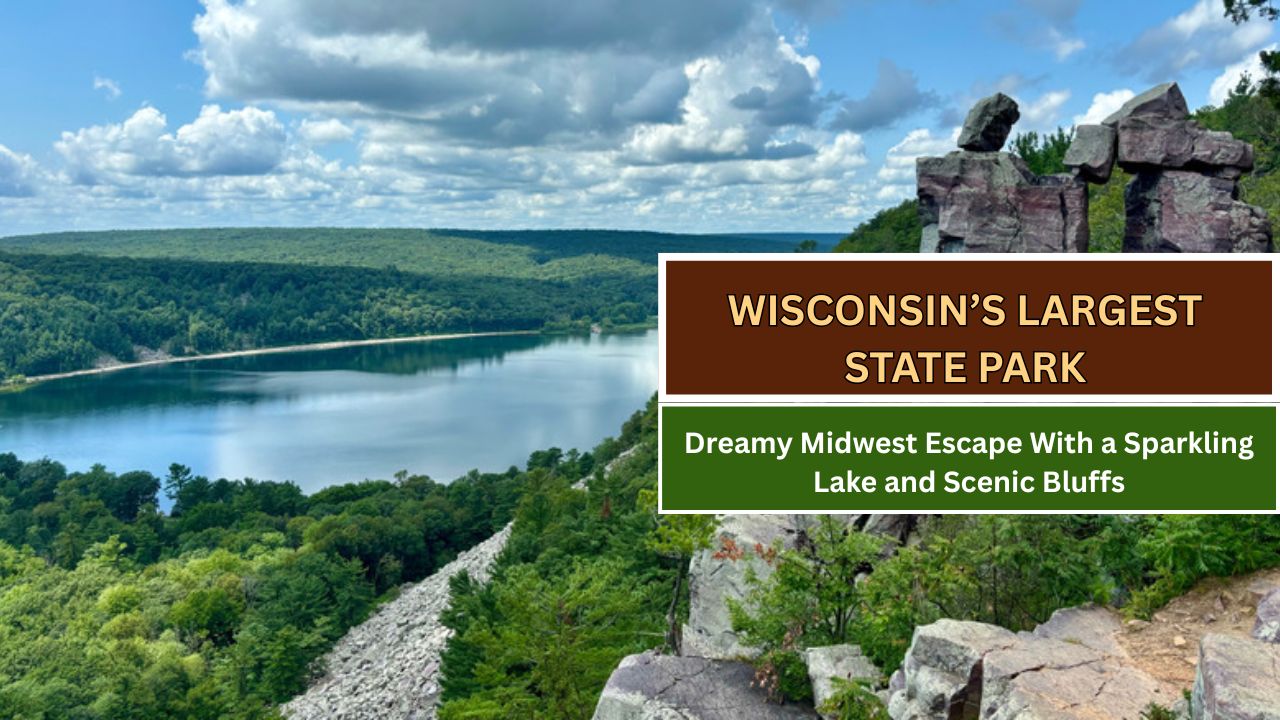When you think of Wisconsin, cheeseheads, Miller beer, and the Green Bay Packers might come to mind first. But this Midwestern gem has more to offer than football and dairy. While the Midwest lacks the headline-grabbing national parks of the West, it makes up for it with a collection of underrated and charming state parks—and Wisconsin’s largest is no exception. This natural treasure draws millions of visitors each year and continues to be one of the state’s most beloved destinations.
Devil’s Lake State Park: Where Nature and History Collide
Devil’s Lake State Park captivates visitors with its towering quartzite bluffs, its peaceful, namesake lake, and a vast network of 29 miles of hiking trails. This land has hosted human life for thousands of years. Native American tribes, particularly the Ho-Chunk Nation, have long revered the area and referred to the lake as Tee Wakącąk, or “Sacred Lake.”
You’ll also find effigy mounds, ancient earthworks built by Indigenous peoples. Similar mounds appear at other scenic Midwestern parks, like one in northeast Iowa.
What makes Devil’s Lake visually striking are its 500-foot-high quartzite bluffs, which offer sweeping, photo-worthy views. But the park’s heart lies in its 370-acre glacial lake, created when ice-age moraines dammed a valley, leaving behind a shimmering, spring-fed reservoir.
This is far more than a scenic picnic spot—it’s a location rich in geology, ecology, and Native American heritage. Whether you’re climbing the cliffs, paddling across the glassy water, or admiring the landscape from below, Devil’s Lake State Park is a must-see destination in the Midwest.
Before you leave, consider visiting Wisconsin’s second-oldest town, a quaint community set on the Mississippi River and full of historic charm.
What to Do at Devil’s Lake State Park
Hiking lovers will feel right at home here. The park offers nearly 30 miles of trails, from lakeside paths to intense climbs up the bluffs. Climbers nationwide come to scale the quartzite cliffs, making Devil’s Lake a top Midwest climbing spot.
Two of the most popular hikes—Balanced Rock Trail and Devil’s Doorway—reward you with jaw-dropping views.
The park features multiple campgrounds, accommodating both tents and RVs. Campsites fill quickly, especially during peak seasons, so it’s best to book early. To save time at the gate, purchase your vehicle admission online before arriving.
Looking to relax? The lake has two sandy beaches perfect for swimming. If you prefer being on the water, rent a canoe or kayak and take in the views from the lake itself.
Nature lovers will appreciate the park’s diverse wildlife and plant life. It’s home to species like flying squirrels, red foxes, and rare plants, and it plays a vital role in conservation and outdoor education. The on-site Nature Center offers informative programs on topics ranging from local wildlife to glacial geology and Ho-Chunk history.
The park also sits along the Ice Age National Scenic Trail, showcasing Wisconsin’s glacial past and linking it to other natural wonders across the state.
Where to Stay and Camp at Devil’s Lake State Park
With hundreds of campsites available, Devil’s Lake is a camping haven. Campsites can be reserved up to 11 months in advance, but spontaneous campers can also book same-day spots when available.
The park’s main campgrounds include:
- Quartzite Campground
- Northern Lights Campground
- Ice Age Campground
In addition to these, there are nine group sites that can host another 400 campers combined.
Amenities include:
- Firewood for sale
- Concession stands
- Dump stations
- Clean restrooms and hot showers
Looking for something a little less rustic? Sky High Camping Resort nearby offers RV sites and cabin rentals, along with seasonal activities like hayrack rides and outdoor movie nights.
For a more luxurious stay, check out the historic Ringling House in Baraboo. This Colonial Revival-style home, listed on the National Register of Historic Places, provides a charming alternative to tents. The accommodation includes guided tours of the home—perfect for travelers who love combining nature with history.
This article has been carefully fact-checked by our editorial team to ensure accuracy and eliminate any misleading information. We are committed to maintaining the highest standards of integrity in our content.

Outside of work, he enjoys playing chess, following cricket, and writing short stories. His commitment to integrity and in-depth analysis strengthens OTE News’ mission of providing trustworthy journalism.



